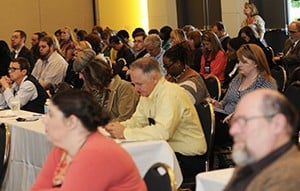Telehealth Forum Surpasses Planners’ Hopes
April 16, 2013 | Not only did the first South Central Telehealth Forum on April 5 in Little Rock exceed the expectations of its organizers, at least one attendee rated it a “smashing success.” The forum was presented by the UAMS Center for Distance Health and the South Central Telehealth Resource Center (SCTRC). The South Central region serves Arkansas, Mississippi and Tennessee. “The telehealth conference was a smashing success,” one of the conference participants wrote in an email to Adam Rule, SCTRC project director. “Good job, I learned some new things, met some new people and spent some time with some old friends — all the stuff a great conference is made of.” Because it was the first such multistate conference the CDH and SCTRC had put together, Rule said, he tried to temper his expectations and hoped at least 80 would sign up. He was pleasantly surprised when more than double that number — a total of 191 — attended. Meeting at the Statehouse Convention Center, the conference was held to promote the use of telecommunications technologies to support distance health care. Pre-conference workshops on April 4 included Telehealth Fundamentals and Telepresenting Skills for Clinical Professionals. Rule said they expected 30 at those early workshops but were able to accommodate the 70 who turned out. The conference’s general session featured Curtis Lowery, M.D., professor and chairman of the Department of OB-GYN in the UAMS College of Medicine and director of the Center for Distance Health, as well as speakers from East Tennessee State University in Johnson City, Tenn., and University of Mississippi Medical Center in Jackson, Miss. Conference class sessions were presented on clinical, program development and technical tracks. The sessions included emerging technologies in telemedicine, strategies for integrating telehealth, learning from model programs, telehealth policy, creating a community with telehealth, sustainability, telehealth technology, building a telemedicine network, and telehealth infrastructure considerations. About 50 formal written evaluations have come in so far, and the responses have been overwhelmingly positive, Rule said. “The topics were all so good that it was difficult to choose which to attend,” one attendee wrote. “The breakout sessions I did attend were excellent, and I gained a great deal of knowledge by the choices I made.” Several technology vendors and other businesses and organizations also had booths and exhibitions at the conference. Continuing education credits were offered. People who came to the conference were from a wide variety of health care or health care-related professions, Rule said. They ranged from physicians and nurses to telehealth administrators and technicians. The SCTRC functions primarily through a website that works in partnership with the Center for Distance Health’s Training Center. The SCTRC focuses on telehealth education and peer interactions online. It also conducts hands-on training in its training center or on site. The conference helped make people more aware of what the center does. “It increases our profile and word of mouth,” Rule said. “People need to know we’re here. We want to be the resource that people think about when exploring telehealth. We want to help them at any level of the learning process they are in.” |


